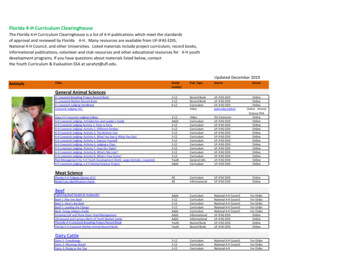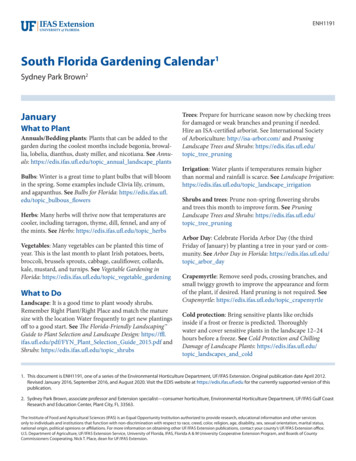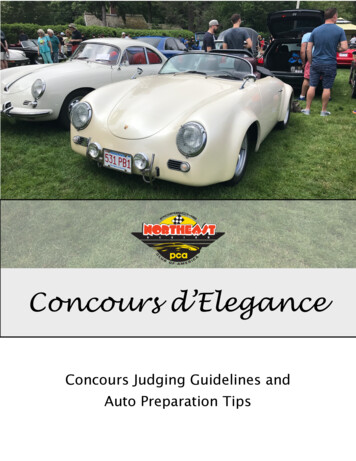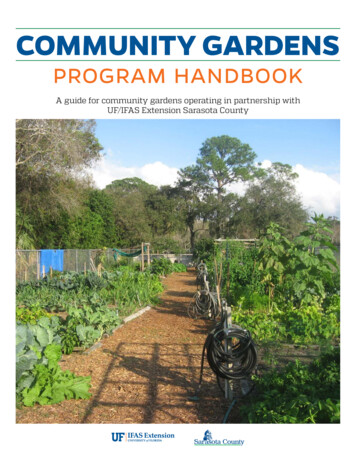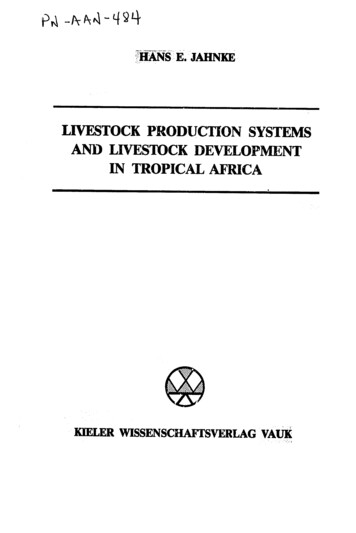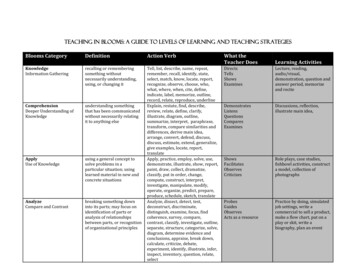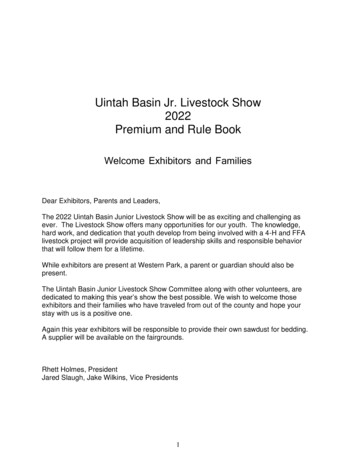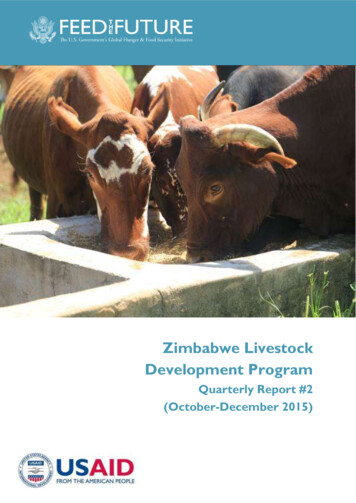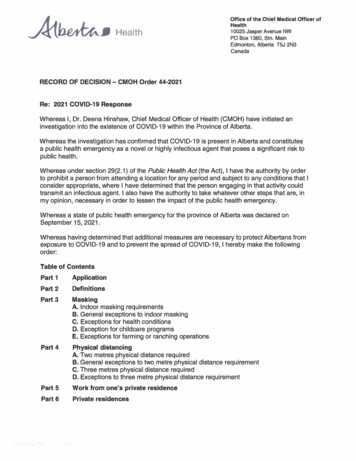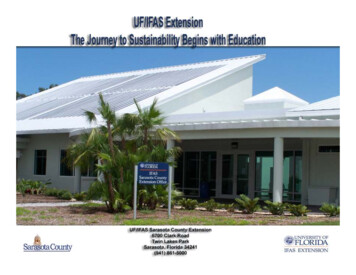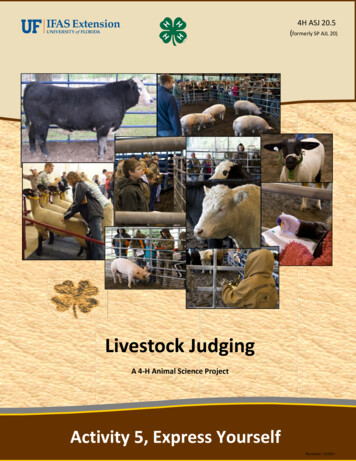
Transcription
4H ASJ 20.5(formerly SP AJL 20)Livestock JudgingA 4-H Animal Science ProjectActivity 5, Express YourselfReviewed: 10/2021
CREDITS AND ACKNOWLEDGMENTS4-H LIVESTOCK JUDGING was developed through a team effort with the Florida 4-H YouthDevelopment Program, Department of Family, Youth and Community Sciences, and theDepartment of Animal Science, The Institute of Food and Agricultural Sciences, University ofFlorida.This edition of the Livestock Judging curriculum package was created by Chad Carr, AssistantProfessor, Justin Crosswhite, Graduate Assistant, and Amanda Johnson, UndergraduateAssistant, Department of Animal Sciences. Authors of previous editions include: Julie Sextonand Karen Strickland, former Project Assistants, Allen Stateler, former Graduate Assistants;Saundra TenBroeck, Associate Professor and Youth Livestock Extension Specialist,Department of Animal Sciences, Tim Marshall, Associate Professor, Department of AnimalSciences and Deborah J. Glauer, Extension Youth Development Specialist and Animal ScienceDesign Team Leader, Department of Family, Youth and Community Sciences.Technical review and assistance for this edition was provided by members of the 4-H LifeSkills Animal Science Action Team—Amanda Thein, Nassau County 4-H Agent, ChrisDeCubelis, Gilchrist County 4-H Agent, and Joy C. Jordan, Associate Professor a/4-H YouthDevelopment Curriculum Specialist, Department of Family, Youth and Community Sciences,University of Florida, Institute of Food and Agricultural Sciences.An Equal Opportunity Institution. UF/IFAS Extension Service, University of Florida, Institute ofFood and Agricultural Sciences, Nick T. Place, dean for UF/IFAS Extension. Information oncopies for purchase is available from IFAS Extension Bookstore, University of Florida, PO Box110011, Gainesville, FL 32611-0011 (visit our website at: ifasbooks.ufl.edu). Informationabout alternate formats is available from IFAS Communications, University of Florida, PO Box110810, Gainesville, FL 32611-0810. Published January 2012 as 4HASJ20.5, UF/IFASExtension. Reviewed January 2015.4-HLivestock Judging, IntroductionPagePage2 2
Activity 5OBJECTIVES: For youth to: discover terminology usedto describe and comparelivestock.add to vocabulary bylearning livestock terms.LIFE SKILL: Communicating Skills Self-confidenceThe youth have learned and added many new livestock words to theirvocabulary in the first three activities. In this activity, they will expandthat basic terminology and learn more specific terms that are used in thelivestock industry. Below is a list of words or phrases that are used todescribe different animals or features. Many of these terms are notspecies specific and mean the same thing for almost all animals. Condition, Finish or Leanness - all are used to denote fatness. Theterm finish is used to describe fat on market cattle and lambs,condition is used with breeding stock, and leanness is used withmarket hogs. Growth - the characteristics of having adequate size and weight at acertain age. Balance - a proper proportion and blending of parts of the animal,essentially “how the parts fit together.” Includes structuralcorrectness, symmetry and quality. Balance is primarily evaluatedfrom a side view. Ruggedness, Stoutness - traits associated with potential durabilityand serve as a loose indicator of growth. These include foot size,circumference of the cannon bone (from the knee to the ankle), andstructural width. Quality - a general term that infers smoothness and refinement.Refinement of hair coat, freedom of wrinkles in hogs and lambs,freedom of roughness, patchiness in cattle indicates quality. Scale or Frame - the size of the animal as determined by skeletalstructure, independent of weight. The height, length and width asthey predict an animal’s mature size. Broodiness - female breeding stock term that means she has afavorable combination of characteristics to be a good mother.Depth, capacity, stoutness, prominence of teats and/or mammarysystem, and correctness of vulva.MATERIALS:Copies of BASIC LIVESTOCKTERMS and SPECIES SPECIFICTERMS for each youth. Easel and flip chart orchalkboard markers or chalkTIME:1½ HoursSETTING:A comfortable roomwith tables and chairs.ADVANCE PREPARATION:Ask a youth with livestockjudging experience to prepare aset of oral reasons to give infront of the group.Page 97
Breed Character - characteristics that separate breeding stock of one breed from other breeds,primarily by differences of the head: shape, length, dish of face, width of muzzle, shape of polland ears, color markings and wool covering in sheep. Trimness - freedom from external fat. Muscling - having greater meat yield per carcass weight. Maturity - an animal’s degree of physiological development relating to sexual puberty, maturesize, and body composition. Structural Soundness - the desirability or correctness of the skeletal structure, with majoremphasis on straightness of top and proper feet and leg structure. Sexual Characteristics - characteristics that distinguish the female from the male. FemininityIndicated by refinement of the head, neck and shoulders. Masculinity- Indicated by boldness ormassiveness of head and crest, thickness of the neck and development of the forequarter.Sexual character varies widely in each breed within a species; however, there are some commontypes and ideals found within most species. These can be broken up into necessary and desirablesexual characteristics. Necessary sexual traits are those necessary for reproduction in that individual.Some of these traits might include the development and spacing of the appropriate number of teats,lack of difficulty during parturition (giving birth) and the proper formation of testicles and vulvas.Desirable sexual traits are genetic traits that producers wish to pass along to the individual'soffspring. The traits that a producer finds valuable vary widely with personal preference, use andbreed demands. Some desirable traits might include femininity or masculinity of the head and neck,maximum number of offspring per year or lack of pendulous (hanging) sheaths.Activity 5: Express YourselfPage 98
To fully understand and communicate with others in the livestock industry, it is essential thateveryone use common terminology. The person to whom you are communicating should beable to understand exactly what you want them to. Today you will develop a basicvocabulary of livestock terms, learn the meanings of basic livestock terms and learnsynonyms to be used in oral reasons. So let's get started.Play “phrase it” in livestock terminology Have a youth with livestock judging experience to give a sample set of oralreasons. This will familiarize youth with some terms used to describe andcompare livestock animals. Play the phrase game. Divide the group into two teams. Write the general trait "frame" on the board or flip chart. Have the teams alternateyouth (first one answers, then another) and come up with a different phrase or way ofdescribing an advantage in this trait. Examples: long bodied, large framed, standing onlength of leg.—write the answers on the board or flip chart. The leader or an experienced youth should evaluate and score the phrases. For eachgood answer, the team gets one point. For each outstanding answer, the team gets twopoints. For each poor or invalid answer, the team loses a point. The number of rounds played depends on the number of youth in the group. Make sureeveryone gets at least two turns. Repeat game with the terms: muscle, structure, volume and carcass. Give youth copies of BASIC LIVESTOCK TERMS handout and discuss the information withyouth.Activity 5: Express YourselfPage 99
Why is there a variety of ways to say or express the same thing?To provide ways to express a certain trait in almost any situation; to give some varietyto a set of reasons. What is the difference between an animal’s frame or scale and its growth?Frame or scale describes an animals length, height, and width as serves as a predictionof growth. Growth is used to describe size and weight at a certain age, but also topredict future growth potential of his/her progeny based on performance records. List a creative and specific term you used when describing traits. Was it challenging to describe a single trait in many different ways? Why might it be necessary or important to know this?It is important to learn the terms used to describe and compare livestock to aid inevaluating the animals and to give effective oral reasons. List some examples of new words or phrases you learned in this activity. Think of different ways to describe your home, pet or family member. Try to use very specificwords and avoid general statements. Show a picture of an animal or view a live animal and have the youthdescribe the animal on its own merit, using correct and descriptiveterminology.Activity 5: Express YourselfPage 100
BREEDING CATTLE TERMINOLOGYGrowth/MaturityPositivesNegativesHigher performingSlow growingFaster growingFrail featuredMore weight per day of ageFine bonedStouter featuredExcessively large framedMore powerfully constructedExcessively small framedHeavier bonedMore moderate in frame and ultimate maturesizePHRASES:- a more powerfully made, bigger footed bull with more weight per day of age-a stouter featured, heavier boned, higher performing bullStructural CorrectnessPositivesNegativesMore correctly structuredShort stridedLonger stridedIll structured as evidenced by .Truer movingStraight shouldered/kneed/pasterned/hockedSounder movingSmall footedBigger footedMore structurally correctMore functionally correctPHRASES:- a more structurally correct heifer that was truer and freer moving-a more correctly structured heifer moving off the more correct hind leg set-a freer moving heifer that took a longer, more comfortable stride-a bigger footed more structurally correct bull which should provide more seasons of serviceActivity 5: Express YourselfPage 101
BREEDING CATTLE TERMINOLOGYMusclingPositivesNegativesHeavier muscledLight muscledThicker madeFlat/narrow madeMore muscle shapeTapers out of hipPHRASES:- a thicker made, heavier muscled bullBalancePositivesNegativesBetter/ nicer balanced/patternedPoor balancedBetter/ nicer/ more attractive profilingCoarse shoulderedFlatter r/more attractive frontedBroken/weak toppedLonger fronted/bodied/hippedMore extendedStronger toppedLeveler hippedMore eye appealingPHRASES:-a better patterned, longer fronted heifer that is stronger topped, and leveler hipped-a better balanced, more correctly structured bull that is squarer hipped-a nicer profiling heifer that is stronger in her topline and becomes progressively deeper fromforerib to flankActivity 5: Express YourselfPage 102
BREEDING CATTLE TERMINOLOGYSexual CharacteristicsPositives– HeifersNegativesMore feminine featuredCoarse featuredMore maternal appearingSmall, missapened vulvaBroodierShorter bredLarger and more correct vulva sizeLong, coarse teatsLonger bred as shown by her udder developmentShorter, more refined teatsBullsLarger testicledSmall testicledMore ruggedly madeFrailMore masculineCoarse/pendulous sheathCleaner/less pendulous sheathPHRASES:-a more feminine featured, broodier heifer, that is heavier bred as shown by her udder development-a more ruggedly made, larger testicled bullVolumePositivesNegativesHigher volumedLow volumedBetter/bigger bodiedTight ribbed/flankedBolder sprung/ribbedShallow bodiedMore capaciousFlat ribbedShould be easier keepingDeeper bodied/flankedWider trackingPHRASES:-a better bodied, bolder sprung heifer, that should prove to be the easier keeping brood cow-a bolder ribbed, higher volumed bullActivity 5: Express YourselfPage 103
MARKET CATTLE TERMINOLOGYBalance– See Breeding Cattle SectionMusclePositivesNegativesHeavier muscledLight muscledMore meat-animal shapeFlat/narrow madeMore expressively muscledTapers out of hipMore shape/dimension over the rib and loin ortopFlattens through quarterSquarer hippedNarrow toppedMore bulging/bulging/thicker quarterPHRASES:-he had more shape over this rib and loin and more mass through his hip and quarter-more muscle shape from end to endCorrectness of finish/maturityPositivesNegativesMore correctly/optimally finishedThin finishedMore market readyOver finishedMellower handlingBare handlingTrimmerMore compositionally correctPHRASES:- a more correctly finished steer that appears more market ready through his cod, flank, and brisket- a trimmer patterned, more compositionally correct steer-a more optimally finished steer which handled mellower down his top and over his lower ribActivity 5: Express YourselfPage 104
MARKET CATTLE TERMINOLOGYProduction traitsPositivesNegativesStouter made/featured/bonedFrailMore powerfulLow volumedMore productive/practical appearingLess feeding capacityEasier feedingShort stridedMore feeding capacityIll structuredSounderPHRASES:- a more productive appearing, bolder ribbed steer with more feeding capacity- a sounder footed, bigger bodied, easier feeding steerCarcass termsPositivesNegativesWhole carcass should rib with a larger eyeRib with a small eyeShould rail/generate a higher cutability carcassOverfinished, light muscled, low cutability carcassA carcass with greater red-meat yieldLow dressing percentageA higher dressing percentageLeast apt to make the Choice gradeMore apt to make/reach the Choice gradeThe poorest potential carcass meritBetter potential yield and quality gradecombinationPacker preferredPHRASES:- a more correctly finished, packer preferred steer which should yield a carcass more apt to grade“Choice”- a heavier muscled steer whose carcass should rib with a larger eye- a more optimally finished, heavier muscled steer whose carcass should have more value on mosttraditional gridsActivity 5: Express YourselfPage 105
BREEDING SHEEP TERMINOLOGYGrowth/MaturityPositivesNegativesHigher performingSlow growingFaster growingFrail featuredMore weight per day of ageSmall footedLarger statured/framedSmall statured/framedStouter featuredLow setMore powerfully constructedShort coupledHeavier bonedHeavy conditioned and skeletally matureGrowthierEarly maturingMore extendedMore upstandingTaller frontedLater maturingTrimmer patterned, more youthful and immatureMore potential for future growthPHRASES:- a growthier, more upstanding ewe-a stouter featured, heavier boned, ram with more weight per day of age-a taller fronted, more extended, trimmer conditioned ewe which is later maturingStructural Correctness—see Structural Correctness of Breeding Cattle,substitutingram and ewe for bull and heiferActivity 5: Express YourselfPage 106
BREEDING SHEEP TERMINOLOGYMusclingPositivesNegativesHeavier muscledLight muscledThicker madeFlat/narrow madeMore muscle shapeTapers out of dockPHRASES:- a thicker made, heavier muscled ramBalancePositivesNegativesBetter/ nicer balanced/patternedPoor balancedBetter/ nicer/ more attractive/more stylishprofilingRound/coarse shoulderedFlatter ippedShallower breastedBroken/weak toppedCleaner/more attractive frontedRounds out of dockLonger fronted/bodied/hindsaddled/hippedSteep hipped/dockedStronger toppedHandles with a short hindsaddle/loinLeveler hipped/dockedHandles shorter from the last rib backMore eye appealingSquarer/leveler dockedHandles with a longer hindsaddle/loinHandles longer from the last rib backPHRASES:-from the side, she is cleaner fronted, longer hindsaddled, and squarer out of her dock-a more stylish profiling ewe that is shallower breasted and becomes progressively deeper from breastto flankSexual Characteristics and Volume—see Sexual Characteristics and Volume ofBreeding Cattle, substituting ram and ewe for bull and heiferActivity 5: Express YourselfPage 107
MARKET LAMB TERMINOLOGYMARKET LAMB TERMINOLOGYBalance– See Breeding Sheep SectionMusclePositivesNegativesHeavier muscledLight muscledMore meat-animal shapeFlat/narrow madeMore expressively muscledTapers out of hip/dockProgressively widens from front to rearFlattens through dockHandles with more mass/shape/dimension to topor rack and loinNarrow toppedHandles deeper/fuller/squarer in loin/down topHandles narrow/shallow down topMore bulging/thicker/fuller legFlattens through the legSquarer/thicker out of hip/dockPHRASES:-handles squarer down his top, and was fuller out of his dock and leg-progressively widens from front to rear, and handles with a deeper, fuller loinCorrectness of finish/maturityPositivesNegativesMore correctly/optimally finishedSoft handlingTrimmerOver finishedFirmer/trimmer handlingBare handlingHandles with a more adequate degree of finishPHRASES:- a trimmer patterned, more correctly finished wether that handles firmer down his top and through isforerib-a more optimally finished wether which handled with a more adequate degree of finish down his topand through his lower ribActivity 5: Express YourselfPage 108
MARKET LAMB TERMINOLOGYProduction traitsPositivesNegativesGrowthierLow setMore upstandingShort coupledLarger staturedFrailStouter made/featured/bonedLow volumedMore powerfulHarder feedingMore productive/practical appearingStands:Bolder ribbedStand with his front legs/ kneed-in, turned outDeeper flankedToed outHigher volumedBuckneedStands squarerStands: sickle hocked/on his rear legsCow hockedPHRASES:With hocks bowed out- a growthier, stouter featured, bigger volumed wether which stands squarer on his rear legs- a larger statured, more productive appearing wether which was deeper through his flankCarcass termsPositivesNegativesWhose carcass should open with a larger eyeOpen with a small eyeShould rail/generate a higher cutability carcassOverfinished, light muscled, low cutability carcassA carcass with greater red-meat yieldLow dressing percentageA higher dressing percentageThe poorest potential carcass meritA more shapely carcass, with a greater leg scoreA more packer preferred carcass, resulting in lesscooler shrinkA higher percentage of trimmed hindsaddlePHRASES:- a leaner patterned lamb who handles with more tone to his top and should rail a higher cutabilitycarcass- a heavier muscled wether whose carcass should open a larger eye- a more optimally finished, lamb whose carcass should have less cooler shrink- handles firmer and longer loined and should yield a carcass with a higher percentage of closelytrimmed hindsaddleActivity 5: Express YourselfPage 109
BREEDING HOG TERMINOLOGYGrowth/MaturityPositivesNegativesHigher performingSlow growingFaster/easier growingFrail featuredMore weight per day of ageFine bonedStouter featured/boned/headedShort coupledMore powerfully constructedLow setHeavier boned/structuredEarly maturingTaller frontedLonger bonedMore extendedBigger/larger scaledLater maturingLeaner made/designedPHRASES:- a faster growing, stouter featured, heavier boned gilt-a taller fronted, leaner, later maturing giltStructural CorrectnessPositivesNegativesSounder/looser/more flexibly structuredTight structuredGreater confinement soundnessStraight through shoulder/knee/pastern/hockMore structurally comfortableTight in his/her hockGreater skeletal flexibilityRound/short hippedMore functionally correct in his/her structuraldesignSmall footedMore functionally soundBetter/leveler designedWeak pasternedBigger footedPHRASES:- she was more functionally correct in her structural design having more flex to her hip and hock- a looser structured, more flexibly made gilt-a bigger footed, sounder structured giltActivity 5: Express YourselfPage 110
BREEDING HOG TERMINOLOGYMuscling– See Breeding CattleSexual CharacteristicsPositives– GiltsNegativesMore feminine featured/headedCoarse featuredMore maternal appearingShort neckedLarger and more correct vulva sizeSmall, missapened vulvaLonger neckedCoarse underlineBroodierHas blind/pin nipplesHigher quality, more refined underline whichstarts farther forwardMore evenly spaced teatsBoarsLarger testicledSmaller testicledMore ruggedly madeFrailMore masculineCoarse sheathCleaner sheathedPHRASES:-a more maternal appearing, longer faced, more extended gilt with a higher quality, more refinedunderline-a more ruggedly made, more athletic, larger testicled boarVolumePositivesNegativesNaturally wider structuredLow volumedBolder/more open ribbedTight ribbed/flankedWider chested/basedShallow bodied/flankedHigher volumedFlat ribbedBolder bladedNarrow chestedDeeper bodied/flankedMore capaciousPHRASES:-a more open ribbed, higher volumed gilt-a bolder ribbed, higher volumed bullActivity 5: Express YourselfPage 111
MARKET HOG TERMINOLOGYMusclePositivesNegativesHeavier muscledLight muscledMore meat-animal shapeFlat/narrow madeMore expressively muscledNarrow hippedWorks more muscle thickness from blade to hipNarrow toppedWorks a greater volume of muscle down his top Flattens through the hamMore dimension of muscleBigger/bolder/thicker /squarer toppedMore bulging/thicker/fuller hamPHRASES:-a heavier muscled barrow that has greater muscle dimension from blade to hip-a thicker made gilt with more shape out of her hip and hamLeanness/maturityPositivesNegativesLeaner designedFatReads leaner down his top and in his elbowpocket/jowl/seam of the hamShort coupledTaller frontedLow setLater maturingEarly maturingLonger boned/bodiedMore extendedMore natural/practical amount of external fatPHRASES:- a barrow which reads to be leaner down his top, elbow pocket, and jowl.-a taller fronted, leaner made, later maturing gilt which has more potential for continued lean growthGrowthPositivesNegativesHigher performingSlow growingFaster/easier growingLight weightMore weight per day of agePounds heavierPHRASES:- See Market Hog Production TraitsActivity 5: Express YourselfPage 112
MARKET HOG TERMINOLOGYProduction traitsPositivesNegativesNaturally wider structuredFrail made/boned/headedBolder/more open ribbedLow volumedWider chested/basedHarder feedingStouter made/featured/boned/headedFlat ribbedMore productive/practical appearingNarrow chestedBolder ribbed/bladedTight structuredDeeper flankedStraight through shoulder/knee/pastern/hockHigher volumedTight in his/her hockSounder footedRound/short hippedLooser structuredSmall footedBigger footedPHRASES:- a stouter featured, wider chested, faster growing barrow- a higher performing, sounder footed, more productive appearing gilt- a more open ribbed, easier feeding barrow with more weight per day of ageCarcass termsPositivesNegativesWhose carcass should open with a larger loineyeOpen with a small loineyeA heavier muscled more shapely carcassFat, low cutabillity/low percent lean/musclecarcassA carcass which will probe leaner at the 10th ribA carcass with a thin, poor quality bellyShould rail/generate a higher cutability/percentlean/percent muscle carcassA carcass with greater lean valueWhose carcass should have improved belly qualityPHRASES:- a heavier muscled, thicker topped barrow whose carcass should open with a larger loineye- a leaner designed, gilt whose carcass will probe leaner at the 10th rib- a leaner, heavier muscled barrow that will rail a carcass with greater lean value- faster growing, more productive barrow with a more practical amount of external fat whose carcassshould have improved belly qualityActivity 5: Express YourselfPage 113
SYNONYMSSHOWS:exhibits, displays, reveals, indicates, evidenced byGRANT:concede, admit, realize, agree that, acknowledge, recognizeHOWEVER:nevertheless, although, yet, nonetheless, butALSO:in addition, furthermore, moreover, likewisePOSSESSES:has, representsSURPASSES:exceeds, excels, overpowersLACKS:is deficient, devoid, inferiorMORE:greater amount or quantity, higher degree, additionally, greater, more extensive,surpasses, exceeds, excels, more abundantSINCE:as, because, for the reason thatESPECIALLY:definitely, particularly, explicitly, distinctivelyActivity 5: Express YourselfPage 114
Name4-H Club Motto"To make the best better"4-H PledgeAddressI Pledge:My head to clearer thinkingMy heart to greater loyaltyMy hands to larger service, andName of Club/SchoolMy health to better livingfor my club, my community,my country, and my world.Leader/Teacher's Name4-H ColorsGreen and ��——————-This document is 4H ASJ 20.5, excerpted from 4H-ASJ-20 (formerly 4H AJL 20), 4-H Livestock Judging: a4-H Animal Science Project one of a series of the 4-H Youth Development Department, UF/IFASExtension. Original publication date January 2012. Reviewed July 2018. Visit the EDIS website athttp://edis.ifas.ufl.edu.The Institute of Food and Agricultural Sciences (IFAS) is an Equal Opportunity Institution authorized to provide research,educational information and other services only to individuals and institutions that function with non-discrimination withrespect to race, creed, color, religion, age, disability, sex, sexual orientation, marital status, national origin, political opinionsor affiliations. For more information on obtaining other UF/IFAS Extension publications, contact your county’s UF/IFASExtension office.U.S. Department of Agriculture, UF/IFAS Extension Service, University of Florida, IFAS, Florida A & M University CooperativeExtension Program, and Boards of County Commissioners Cooperating. Nick T. Place, dean for UF/IFAS Extension.
-a better patterned, longer fronted heifer that is stronger topped, and leveler hipped-a better balanced, more correctly structured bull that is squarer hipped -a nicer profiling heifer that is stronger in her topline and becomes progressively deeper from forerib to flank. Positives Negatives etter/ nicer balanced/patterned. Poor balanced
